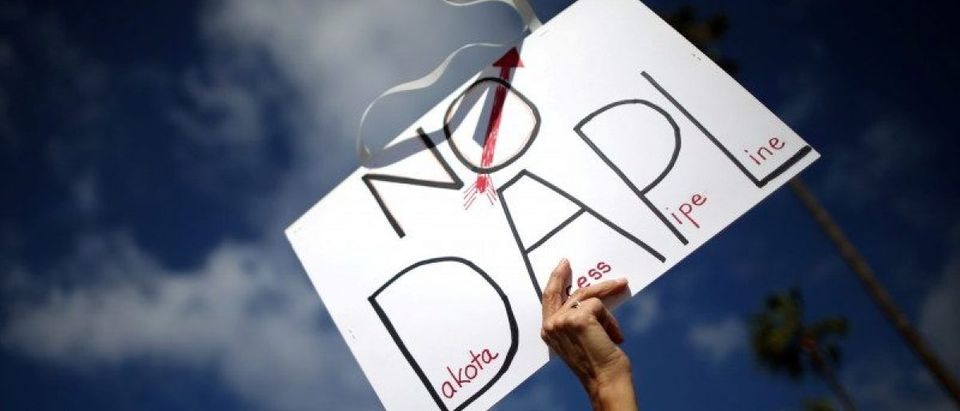I was wasting time on Facebook the other night when the absurdity of what’s going on in North Dakota finally fully occurred to me.
I’m arguing with this guy, saying it’s ridiculous protesters are stopping the Dakota Access Pipeline. The oil is needed. The project is safe. The claims that it disrupts historically significant tribal lands has been thoroughly debunked.
“You don’t understand,” the guy finally says. “We don’t tell the white man where our sacred places are. We keep it a secret.”
Say what?
So it’s just where you say it is, and you don’t say it’s there until someone threatens to turn a buck nearby? Over the seven years and millions of dollars the company spent consulting with tribes and other stakeholders, lining up the very latest in pipeline-building technology, working with communities from North Dakota through South Dakota, Iowa and finally to its end, 1,200 miles away in Illinois to iron out the best route, you just don’t feel comfortable mentioning the sacred burial grounds and potential water sources you see as endangered?
At some point, if we’re still more than a banana republic, this has to end.
This pipeline meets a huge need. The fields of Western North Dakota, which produced 300,000 barrels per day in 2001, turn out 1 million per day now. The added production has overwhelmed the railroad industry. Costs have risen from $50 to $1,400 per car, and South Dakota’s grain farmers are having trouble getting their products to market.
It’s nowhere near any sacred tribal lands, and the useful idiots at the front of the Native American groups leading the protest know this. It’s not on their property – or really even all that close to it. It doesn’t threaten their water supply – the pipeline has to cross the Missouri River somewhere, and it makes that crossing safely by passing more than 90 feet underneath. Unless the technology fails in this case and gravity is defeated for 90 full feet, there is no threat here to the river, and everyone knows it.
It’s a 100 percent sham, and the Obama administration – with the sad predictability of a tattered and torn administration stumbling to the finish line – is now on record siding with irresponsible vandals and violent criminals against property owners trying to produce jobs and tax revenue for the states along the route. It’s the one true duty of government – to protect private property rights – and the Obama administration can’t get it right.
Last week, an Obama-appointed federal judge who actually reviewed the situation and the law ordered protestors to back off and let construction continue on the Dakota Access Pipeline project, which will carry sweet crude oil from the Bakken Oil Fields to Illinois and, for some of it, beyond to Gulf Coast refineries.
But later that day, the Obama administration – which clearly doesn’t seem to get why paying ransom is dumb – caved to those who had destroyed and vandalized equipment, attacked and thrown rocks at officials and threatened and threw sticks at dogs. It ordered three federal agencies to halt work on most of the pipeline until further study.
It’s not easy to get a pipeline approved. In this case, it took approval from environmental bureaucracies in four states. It took negotiating with local and federal officials, working painstakingly with the Army Corps of Engineers and the Department of the Interior to identify the safest, most environmentally friendly route available.
The pipeline company says it tried seven times to meet with the Standing Rock Sioux tribe, which is fronting the protest, but was rebuffed each time.
In other words, the tribe had nothing to say until it was time to get on TV and create an Astroturf protest movement.
Scott Hennen, a leading radio talk show host in North Dakota, said airlines will make the most profit off the protests because the real stakeholders here weren’t the Native Americans and their secret sacred grounds but Soros-funded anti-energy, anti-environment, anti-jobs activists journeying from the coasts to do their virtue signaling and get arrested or at least charged if possible.
Meanwhile, the 12,000 people working on the job, the company that went through a long, laborious and terrifically expensive process in good faith that government would at least back its own rulings and the communities counting on the tax revenue the project would deliver are left to wonder.
Remember, this entire process was set up to require projects of this sort to meet strict environmental standards. It was taken out of the hands of politicians and put into the hands of regulators, engineers and scientists precisely so it could give us accurate – as opposed to politically motivated – results.
Now, a project jumps through the hoops and is found worthy and safe at every level by regulators in the affected area. But because of political considerations – and there is no other plausible explanation – it is now looking at a Keystone-like period of limbo.
Are we a banana republic, or do we stand by our processes? Can we count on the rule of law? Or does making points with extremists count for more? We’re about to find out, and we may well not like the answer.


